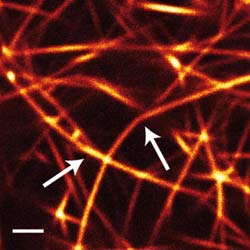Relaxation leads to lower elasticity

Bended actin/fascin bundles indicate stress, incorporated when the network formed. As relaxations over time gradually diminish these tensions, their contribution to the network's elasticity disappears. (length of the bar: 2 µm)<br>Credit: Picture: TUM<br>
Many materials, when observed over a sufficiently long period of time, show changes in their mechanical properties. The exact course of these developments depends on the underlying microscopic mechanisms. However, the microscopic structure and the complexity of the systems make direct observation extremely difficult.
That is why a team led by Professor Andreas Bausch from the Chair of Cellular Biophysics resorted to a model system that can be precisely controlled using actin filaments, a biopolymer that, among other things, is responsible for muscle contractions in the human body. Together with the crosslinking molecule fascin, actin filaments build an interconnected network whose elasticity decreases with increasing age. Deploying a wide-ranging combination of experimental techniques, the researchers have now managed to cast light on the source of these changes.
As the study published in Nature Materials shows, microscopic relaxation processes are the source of the macroscopic changes in the polymer network properties. During the formation of the network internal tensions build up. Because the linking points in the network are not of permanent nature, but rather open and close at random intervals, these tensions gradually diminish. Over a period of ten hours the elasticity drops to about a fifth of the initial value and then remains stable.
“Crosslinked and bundled actin filaments build networks that are essential for the stability of living cells,” says Andreas Bausch, head of the Chair of Cellular Biophysics at the TU Muenchen and member of the Excellence Cluster Nanoinitiative Munich (NIM). “By understanding the microscopic causes for the incredible mutability of the cytoskeleton, we are laying the foundations to advance the development of other polymer materials, as well.”
This research was funded by the Deutsche Forschungsgemeinschaft (Excellence Cluster Nanosystems Initiative Munich, NIM), the Deutscher Akademischer Auslandsdienst (German Academic Exchange Service), the Elite Nework of Bavaria (CompInt), the CNES and the Région Languedoc Roussillon, as well as the Institut Universitaire de France.
Original publication:
Slow dynamics and internal stress relaxation in bundled cytoskeletal networks,
O. Lieleg, J. Kayser, G. Brambilla, L. Cipelletti and A. R. Bausch,
Nature Materials, 10, 236-242 (2011) | DOI: 10.1038/NMAT2939
Link: http://www.nature.com/nmat/journal/vaop/ncurrent/full/nmat2939.html
Media Contact
More Information:
http://www.tum.deAll latest news from the category: Materials Sciences
Materials management deals with the research, development, manufacturing and processing of raw and industrial materials. Key aspects here are biological and medical issues, which play an increasingly important role in this field.
innovations-report offers in-depth articles related to the development and application of materials and the structure and properties of new materials.
Newest articles

Superradiant atoms could push the boundaries of how precisely time can be measured
Superradiant atoms can help us measure time more precisely than ever. In a new study, researchers from the University of Copenhagen present a new method for measuring the time interval,…

Ion thermoelectric conversion devices for near room temperature
The electrode sheet of the thermoelectric device consists of ionic hydrogel, which is sandwiched between the electrodes to form, and the Prussian blue on the electrode undergoes a redox reaction…

Zap Energy achieves 37-million-degree temperatures in a compact device
New publication reports record electron temperatures for a small-scale, sheared-flow-stabilized Z-pinch fusion device. In the nine decades since humans first produced fusion reactions, only a few fusion technologies have demonstrated…





















